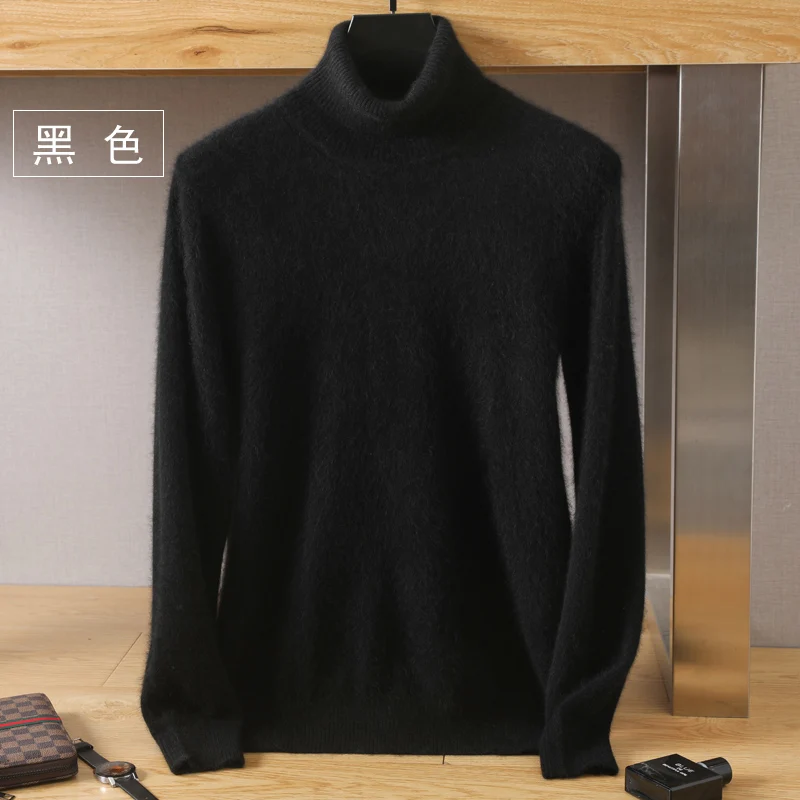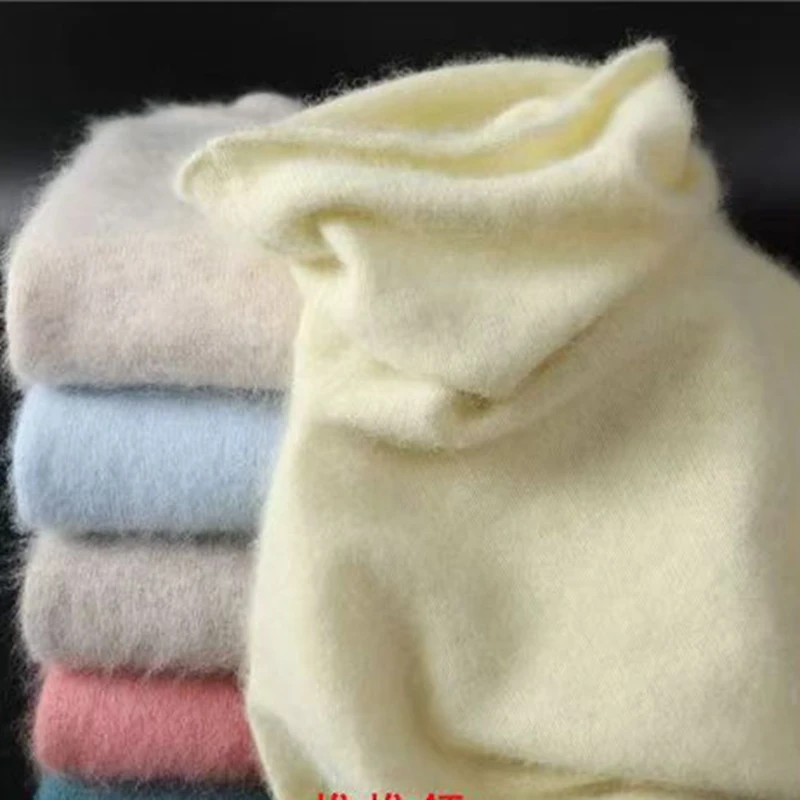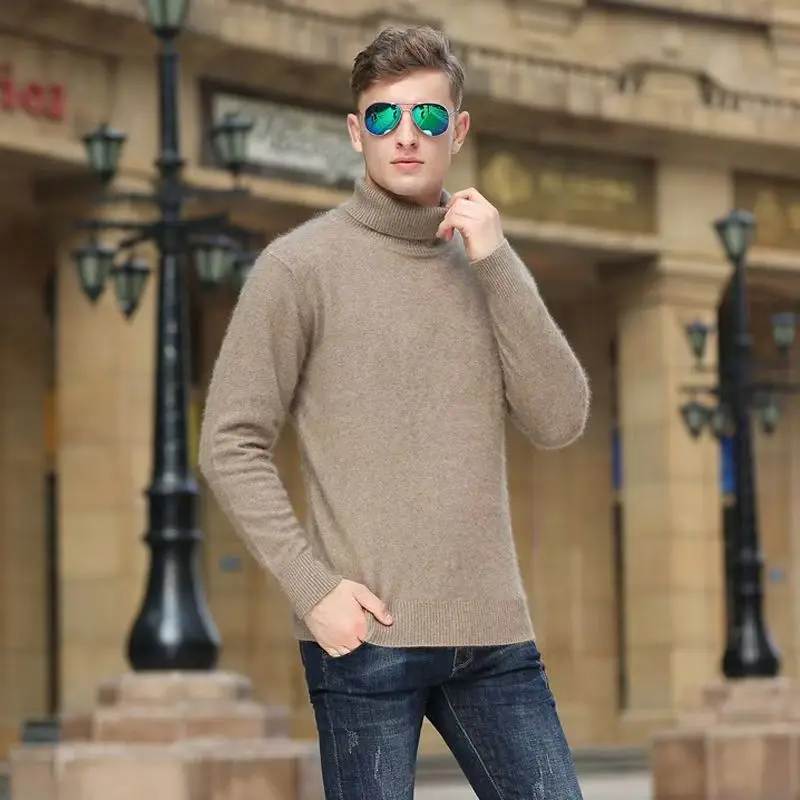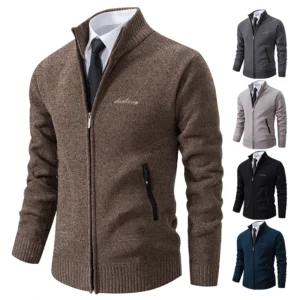Introduction: Understanding the Cashmere Durability Dilemma
When investing in premium cashmere, one question frequently arises: does brushed cashmere sacrifice durability for that irresistibly soft feel? It’s an important consideration, as quality cashmere represents a significant investment in your wardrobe. Both brushed and classic cashmere offer distinct wear properties that directly impact how your garment will look and feel over time.
This guide aims to provide a comprehensive comparison of these two cashmere varieties, focusing specifically on their durability characteristics. We’ll explore the unique properties of each type, examine how they hold up to regular wear, and provide practical insights to guide your purchasing decisions. After all, understanding what you’re investing in helps ensure your luxury pieces remain beautiful for years to come.
While the brushing technique certainly impacts cashmere’s performance, it’s worth noting that underlying quality factors such as fiber grade and construction will significantly influence durability regardless of finishing method. Many enthusiasts are discovering that proper styling tips for cashmere cardigans can also extend the life of their garments, regardless of whether they choose brushed or classic varieties.
What Is Classic Cashmere? Understanding the Traditional Standard
Classic or unbrushed cashmere represents the traditional standard for this luxury fiber. It undergoes minimal additional processing after the yarn has been spun and woven or knitted into fabric. This traditional approach preserves the natural characteristics of the cashmere fibers as they were originally harvested from the goat’s undercoat.
The key characteristics of classic cashmere include:
- Smooth, refined surface texture
- Natural luster and clean appearance
- Visible stitch definition in knitted garments
- Crisp drape that maintains structural lines
In classic cashmere production, after the fabric is created, it undergoes gentle washing and minimal finishing that preserves the integrity of the fiber structure. This traditional processing approach leaves the fibers in their natural alignment, contributing to classic cashmere’s inherent resilience.
The definitive guide to classic cashmere fabric explores these qualities in greater depth, but what’s most relevant to durability is how the intact fiber structure creates a naturally resilient material. The fibers remain tightly bound within the yarn, creating a smooth surface that resists snagging and excessive friction. This foundational structure gives classic cashmere its reputation for longevity when properly maintained.
For those interested in experiencing traditional cashmere quality, our collection of cashmere sweaters showcases the elegant drape and refined appearance characteristic of classic processing methods.
The Brushed Cashmere Process: How Luxury Gets Softer
Brushed cashmere undergoes an additional finishing process designed to enhance its natural softness. This mechanical treatment uses specialized equipment to gently lift and loosen some of the surface fibers, creating a plush, cloud-like texture that feels incredibly soft against the skin.
The brushing process typically involves several carefully controlled steps:
- The finished cashmere fabric is passed over specialized teasel brushes or fine wire brushes
- These implements gently catch and lift some of the surface fibers
- The raised fibers create a soft “halo” effect around the base fabric
- Multiple passes may be made, with intensity carefully controlled to achieve the desired softness
This process intentionally disrupts the aligned fiber structure to create greater surface area and a loftier feel. When you touch brushed cashmere, what you’re feeling is thousands of fine fiber ends that have been teased up from the base fabric, creating an incredibly plush sensation against the skin.
Manufacturers must carefully balance the brushing intensity—too light, and the luxurious softness isn’t achieved; too aggressive, and the fabric’s structural integrity could be compromised. High-quality brushed cashmere is processed with precision to enhance softness while maintaining fundamental durability.
For those interested in the technical aspects, our ultimate guide to brushed cashmere softness provides more detailed information about the various brushing techniques and their effects on the fiber structure. If you’re ready to experience this incredible softness for yourself, our brushed cashmere sweaters collection offers premium examples of expertly finished garments.
Durability Factors: The Science Behind Cashmere Longevity
To truly understand cashmere durability, we must examine the fundamental factors that influence how well any cashmere garment will wear over time, regardless of whether it’s brushed or classic.
Fiber Length (Staple Length)
Fiber length is perhaps the most critical factor in determining cashmere’s durability. Premium cashmere typically features fibers exceeding 36mm (1.4 inches) in length. These longer fibers can be spun into stronger yarns with fewer exposed ends, significantly reducing pilling potential. Shorter fibers tend to work their way out of the yarn more easily, creating the small balls of fiber known as pills on the fabric surface.
Ply Count
Ply refers to the number of yarns twisted together to create the final thread used in knitting or weaving:
- Single-ply yarns create softer, lighter fabrics but generally offer less durability
- Two-ply construction (two yarns twisted together) provides an excellent balance of softness and strength
- Multi-ply constructions offer maximum durability but may sacrifice some softness
Knit/Weave Density
Tightly knitted or woven cashmere restricts fiber movement, improving resilience and shape retention. Looser constructions may feel softer initially but typically show wear more quickly as fibers have greater freedom to migrate and pill.
Micron Count
Fiber fineness (measured in microns) influences both softness and strength:
- Grade A cashmere measures under 16 microns in diameter
- Finer fibers create softer fabric but must be properly constructed to maintain durability
- Coarser fibers might offer more durability but sacrifice the luxurious hand-feel
Manufacturing Quality
Even with excellent raw materials, poor manufacturing can undermine durability. Quality markers include:
* Even stitches without irregularities
* Properly finished seams and edges
* Consistent tension throughout the garment
* Thorough cleaning to remove short fibers that might cause early pilling
Understanding these fundamentals helps explain why some cashmere pills excessively while other pieces remain beautiful for years. For more detailed information about this common concern, our guide on why cashmere pills and how to fix it offers practical solutions.
Classic Cashmere Durability Profile: Strengths and Limitations

Classic cashmere offers distinct durability advantages that stem from its preserved fiber structure. With fibers remaining in their natural alignment within the yarn, classic cashmere typically demonstrates excellent resilience over time.
Key Durability Strengths
- Initial Integrity: The natural fiber alignment creates a smooth surface that resists snagging and friction
- Improving Appearance: Quality classic cashmere often improves after several gentle cleanings as the fibers settle and conform
- Shape Retention: The intact fiber structure helps garments maintain their original dimensions and silhouette
- Wear Resistance: High-friction areas like underarms and cuffs typically hold up better compared to brushed alternatives
- Longevity: With proper care, classic cashmere often provides decades of wear
Limitations and Considerations
- Break-in Period: Some classic cashmere may feel slightly less soft initially and requires a break-in period
- Initial Pilling: Even high-quality classic cashmere typically experiences some pilling during the first few wears as loose fibers work their way out
- Care Sensitivity: Improper washing or drying can compromise the fiber structure and reduce longevity
Classic cashmere’s tightly-twisted yarns maintain their integrity through repeated wearing and cleaning cycles. Over time, with proper care, the fabric often becomes more comfortable while maintaining its refined appearance. The natural resilience of unbrushed fibers allows them to recover from compression and resist the formation of permanent wear patterns.
For those prioritizing long-term performance, our collection of men’s cashmere turtlenecks exemplifies the refined durability characteristic of classic cashmere construction.
Brushed Cashmere Durability Profile: What Changes and Why
The brushing process fundamentally alters cashmere’s durability profile by disrupting the natural fiber alignment. Understanding these changes helps explain the different wear patterns you can expect with brushed cashmere garments.
How Brushing Impacts Durability
Pros:
* Creates immediate exceptional softness without requiring break-in
* Can mask minor inconsistencies in fiber quality
* Often feels warmer due to increased air trapped between raised fibers
* Provides a more casual, relaxed aesthetic
Cons:
* Loosened surface fibers shed more readily during early wear
* Increased likelihood of pilling, especially in high-friction areas
* Greater vulnerability to snagging on rough surfaces
* May show compression wear more quickly than classic cashmere
The Mechanics Behind These Changes
During brushing, the process deliberately loosens and lifts some fibers from the yarn’s core structure. These loosened fibers create the luxurious soft hand-feel but are also more vulnerable to being pulled away from the fabric during wear. The raised fibers have less structural support, making them more susceptible to breaking, tangling, and forming pills.
High-quality brushed cashmere starts with excellent base fibers and employs controlled brushing techniques that enhance softness while minimizing structural compromise. The intensity of brushing directly correlates with both increased initial softness and potential durability concerns—manufacturers must balance these competing factors carefully.
Over time, brushed cashmere typically loses some of its initial loft as the raised fibers shed or mat down. This doesn’t necessarily mean the garment is deteriorating, but rather settling into its more stable form. For a more detailed comparison beyond durability aspects, our guide on brushed vs traditional cashmere provides additional insights.
Head-to-Head Durability Comparison: Brushed vs. Classic Cashmere

To make the most informed decision between brushed and classic cashmere, let’s directly compare their durability characteristics across key performance factors:
| Durability Factor | Classic Cashmere | Brushed Cashmere |
|---|---|---|
| Initial fiber shedding | Minimal to moderate | Moderate to significant |
| Pilling resistance | Initial pilling diminishes with care | May continue longer, especially in friction areas |
| Shape retention | Excellent with proper care | Good to excellent depending on brushing intensity |
| Resilience to friction | High | Moderate |
| Long-term softness | Maintains and often improves | May lose some initial loft but remains soft |
| Appearance after multiple seasons | Refined, often improves | May show more visible wear patterns |
Performance in Different Scenarios
Daily Wear Items: Classic cashmere generally outperforms brushed varieties for garments worn frequently, such as everyday sweaters or cardigans. The intact fiber structure better withstands repeated friction from regular movement and layering.
Occasional Luxury Pieces: Brushed cashmere excels for items worn less frequently, like special occasion sweaters or loungewear, where immediate luxurious feel takes priority over maximum longevity.
Layering Pieces: When worn under coats or jackets, brushed cashmere may experience accelerated wear in high-friction areas where the garments rub against each other.
Direct Skin Contact: Both perform well for items worn against the skin, though sensitive individuals often prefer the exceptional softness of brushed varieties.
Over multiple seasons, classic cashmere typically develops a beautiful patina while maintaining its fundamental structure. Brushed cashmere, while still luxurious, may show more pronounced wear patterns, particularly in areas of high friction. For elegant options with different wear characteristics, our women’s cashmere turtlenecks collection offers both classic and brushed varieties.
Expert Care Strategies for Maximum Cashmere Longevity
Proper care dramatically extends the lifespan of both cashmere varieties. With some specialized approaches for each type, you can maximize the durability of your investment pieces.
Universal Care Principles
- Gentle Washing: Hand wash in lukewarm water with a mild detergent specifically formulated for cashmere or wool
- Minimal Agitation: Soak rather than rub, gently squeezing suds through the fabric
- Careful Rinsing: Use clean, room-temperature water until all soap is removed
- Proper Drying: Press water out between towels (never wring), then lay flat on a fresh towel away from direct heat or sunlight
- Storage: After completely dry, fold (don’t hang) and store in breathable cotton bags with cedar blocks to deter moths
Special Care for Classic Cashmere
- Initial gentle washes help remove manufacturing residues and stabilize the fiber structure
- After several wears, minor pilling can be removed with a cashmere comb to reveal the smoother underlying fabric
- Brushing with a soft garment brush helps maintain surface appearance
Special Care for Brushed Cashmere
- Use extra care when de-pilling, using only specially designed cashmere combs with shallow teeth
- Keep brushing to a minimum to avoid further loosening fibers
- Consider less frequent washing, with more emphasis on airing between wears
- Handle with particular care when wet, as the loosened fibers are more vulnerable
With consistent proper care, even frequently worn cashmere can last for many years. Many customers find that cashmere cardigans are worth the investment specifically because of their exceptional longevity when properly maintained.
Quality Indicators: How to Identify Durable Cashmere Before Purchase
Identifying high-quality cashmere before purchase helps ensure you’re investing in a truly durable piece, regardless of whether it’s brushed or classic.
Universal Quality Markers
- Soft yet substantial feel: Premium cashmere has weight and body despite its softness
- Resilient bounce: When gently compressed in your hand, quality cashmere springs back quickly
- Even coloration: Look for richness and consistency in dye application
- Clean finishing: Examine seams and edges for neat, tight execution
- Limited initial shedding: Excessive loose fibers when lightly rubbed suggests poor quality
Brushed Cashmere Specific Checks
- Controlled loft: The surface should feel plush but not excessively fluffy
- Consistent brushing: Examine for uniform texturing across the entire garment
- Core stability: Despite surface softness, the underlying fabric should feel substantial
- Balanced weight: Extremely light brushed cashmere may indicate over-processing
Questions to Ask Retailers
- What is the cashmere grade and fiber length?
- Is it two-ply or single-ply construction?
- Where was the cashmere sourced from?
- How is the garment constructed (fully-fashioned vs. cut-and-sewn)?
Remember that price often (though not always) correlates with quality in cashmere. Suspiciously inexpensive cashmere typically involves compromises in fiber quality or construction that directly impact durability. For more comprehensive information about identifying quality sources, our cashmere origins quality guide provides invaluable insights.
Optimal Use Cases: Matching Cashmere Type to Your Lifestyle
To maximize satisfaction with your cashmere investment, consider how each type aligns with specific wardrobe needs and lifestyle patterns.
Classic Cashmere Ideal Applications
- Work wardrobe staples worn weekly or more frequently
- Structured garments where shape retention is paramount
- Travel pieces that need to look fresh despite frequent packing
- Investment basics expected to last many seasons
- Heritage items intended to be passed down or kept for decades
Brushed Cashmere Ideal Applications
- Luxury loungewear where exceptional softness is the priority
- Special occasion pieces worn selectively for maximum impact
- Home accessories like throws and pillows with minimal friction
- Gifting pieces where immediate tactile impression matters
- Cold-weather accessories like scarves where softness against sensitive skin is valued
Lifestyle Considerations
- Active lifestyles with frequent movement typically benefit from classic cashmere’s resilience
- Varied climates may call for classic cashmere’s adaptability through layering
- Low-maintenance preferences might favor classic cashmere’s easier care requirements
- Sensory sensitivities often lead people to prefer brushed cashmere’s exceptional softness
For versatile options that work in multiple settings, our cashmere cardigans collection offers styles suitable for different lifestyle needs.
Cashmere Wrap Sweaters, Women's Cashmere Pullovers
$75.89 Select options This product has multiple variants. The options may be chosen on the product pageCashmere Cable Knit Sweaters, Women's Cashmere Pullovers
Price range: $111.82 through $112.93 Select options This product has multiple variants. The options may be chosen on the product pageCropped Cashmere Sweaters, Women's Cashmere Pullovers
$155.77 Select options This product has multiple variants. The options may be chosen on the product page- Price range: $102.02 through $109.37 Select options This product has multiple variants. The options may be chosen on the product page
Oversized Cashmere Sweaters, Plus Size Cashmere Sweaters, Women's V-Neck Cashmere Sweaters
$136.87 Select options This product has multiple variants. The options may be chosen on the product page- Price range: $108.11 through $130.03 Select options This product has multiple variants. The options may be chosen on the product page
Hybrid Approaches: When Manufacturers Combine Techniques

Innovative manufacturers have developed techniques that capture benefits from both cashmere types by selectively applying brushing to specific areas of garments. This strategic approach can create ideal comfort zones while preserving structural integrity where it matters most.
Common hybrid techniques include:
- Brushing only the interior facing side of garments for next-to-skin comfort while maintaining exterior resilience
- Selectively brushing collar and cuff areas where softness against sensitive skin is appreciated
- Creating contrast panels with different finishing techniques within the same garment
- Using lighter brushing techniques that enhance softness without significantly compromising fiber structure
These balanced approaches represent the cutting edge of cashmere production, offering thoughtful compromises between immediate luxury feel and long-term performance. The best examples maintain the core integrity of the yarn while still providing enhanced comfort in targeted areas.
Estate Cloth works with manufacturers who have mastered these selective techniques, creating garments that combine the best attributes of both cashmere variants.
Real-World Durability: What Experts and Customers Report
While technical specifications provide valuable insight, real-world experience from both industry professionals and everyday cashmere enthusiasts offers practical perspective on durability differences.
Textile conservators frequently note that classic cashmere in museum collections has demonstrated remarkable longevity, with some pieces maintaining their integrity for over a century with proper care. These experts typically observe that brushed cashmere is a relatively modern innovation primarily focused on enhancing initial tactile appeal rather than historical longevity.
Professional cleaners report that brushed cashmere typically requires more delicate handling during the cleaning process, as the raised fibers are more vulnerable to matting or damage during wet processing. They often recommend specialized cleaning approaches for these garments.
Customer experiences generally align with technical expectations:
“My classic cashmere sweaters initially needed a few wears to soften up, but five years later, they still look nearly new. The brushed cashmere cardigan I bought the same year still feels incredibly soft but has developed noticeable wear patterns under the arms and along the sides.”
“I’ve found brushed cashmere to be perfect for scarves and special occasion pieces, but for my everyday office sweaters, I exclusively buy classic cashmere now after experiencing the difference in how they wear over time.”
These real-world observations confirm that while both types can provide years of enjoyment, their performance trajectories differ in ways consistent with their structural differences.
Is the Extra Softness Worth It? Making Your Final Decision
When deciding between brushed and classic cashmere, the fundamental question becomes whether the exceptional initial softness of brushed cashmere justifies its potentially shorter peak appearance lifespan. This decision ultimately depends on your personal priorities, how you plan to use the garment, and your expectations for longevity.
Consider these decision factors:
- Frequency of wear: Daily or weekly use favors classic cashmere’s resilience
- Intended lifespan: Heirloom expectations align better with classic construction
- Sensitivity needs: Physical comfort sensitivities might prioritize brushed softness
- Care commitment: Willingness to provide special handling supports brushed options
- Replacement expectations: How long do you expect the item to remain in your wardrobe?
Remember that quality fundamentals matter more than brushing technique. A premium-quality brushed cashmere garment will typically outlast a poor-quality classic cashmere piece. Look for excellent fiber quality, proper construction, and reputable manufacturing regardless of which type you choose.
For those building a business casual wardrobe, our guide to versatile cashmere layers for business casual settings provides additional context for making practical decisions about which cashmere type might best suit your professional needs.
FAQs: Common Questions About Cashmere Durability
Does brushed cashmere always pill more than classic cashmere?
While brushed cashmere is generally more prone to pilling due to its loosened fiber structure, high-quality brushed cashmere with excellent fiber length can still outperform poor-quality classic cashmere. The underlying fiber quality and construction remain the most important factors.
Is classic cashmere always scratchy compared to brushed versions?
This is a common misconception. Premium classic cashmere with fibers under 16 microns is remarkably soft without brushing. The perception of scratchiness usually indicates lower-quality cashmere rather than simply being unbrushed.
How many years should quality cashmere last?
With proper care, classic cashmere typically maintains its appearance for 10+ years of regular wear, while brushed cashmere may show more significant signs of wear after 5-7 years of similar use. Both can remain functionally wearable for decades.
Does washing cashmere at home ruin it?
Gentle hand washing with appropriate detergent actually benefits cashmere by removing oils and dirt that attract moths and cause fiber damage. The key is using lukewarm water, minimal agitation, and proper flat drying techniques.
Can brushed cashmere be “fixed” if it starts looking worn?
While severe pilling or matting is difficult to reverse completely, professional reconditioning services can sometimes restore some of brushed cashmere’s loft and appearance. Prevention through proper care remains the best approach.







